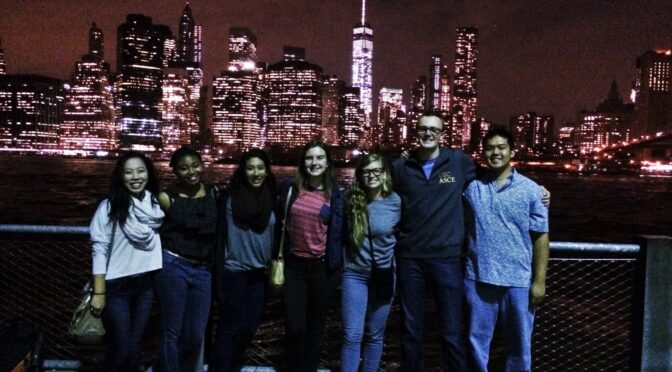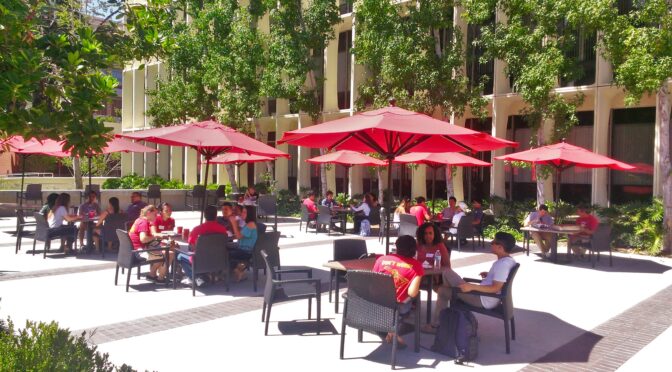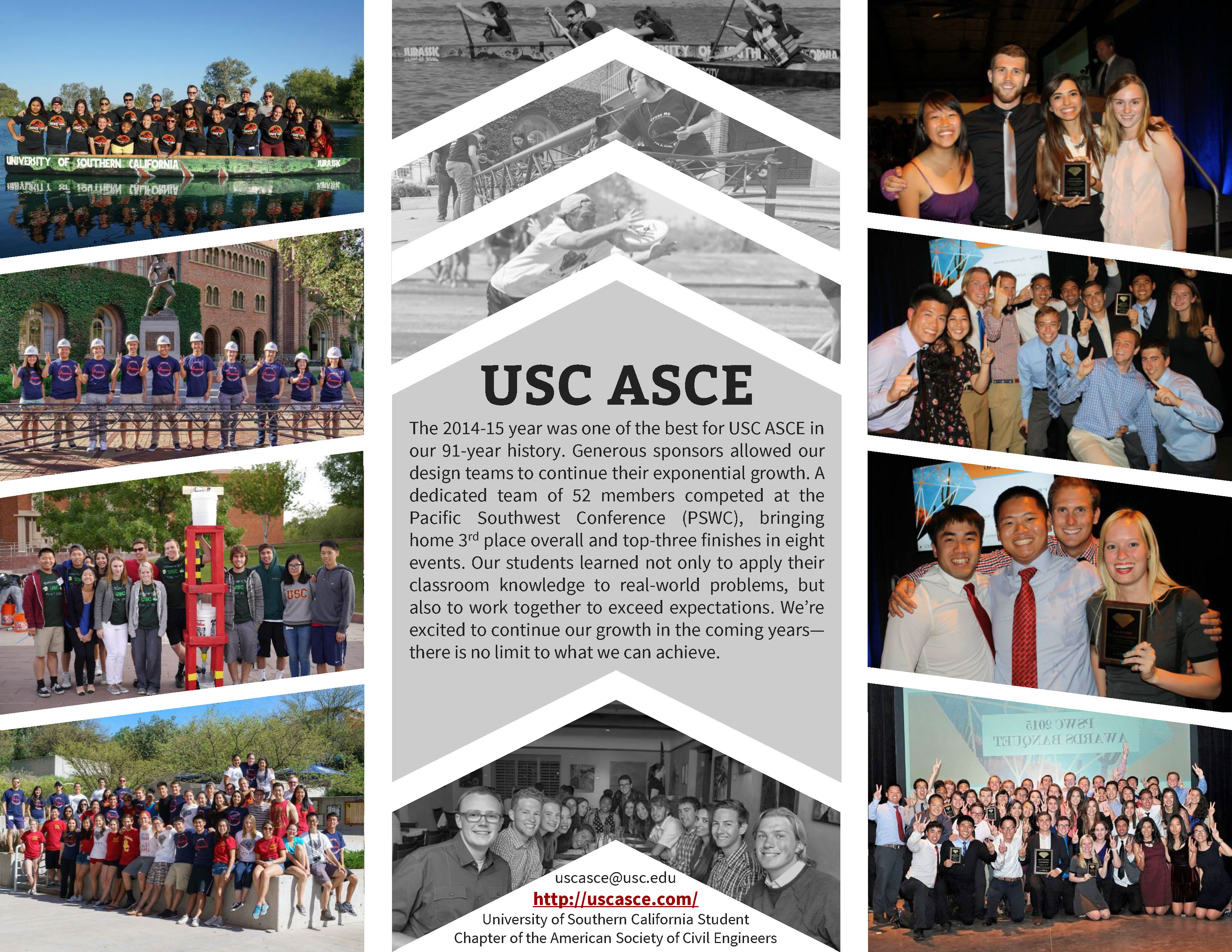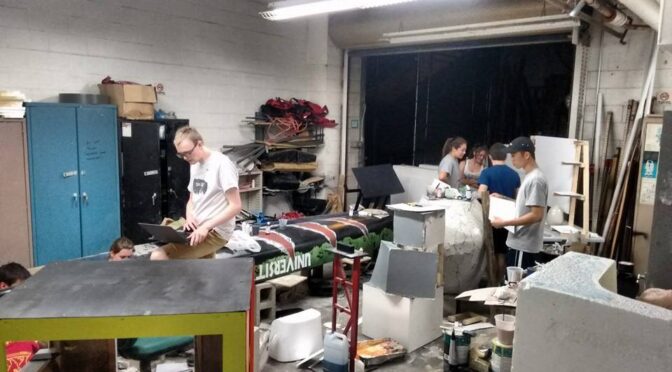Eight USC ASCE representatives spent five days in New York City for the ASCE 2015 Convention. As the annual worldwide professional gathering for the American Society of Civil Engineers, the ASCE Convention is a phenomenal opportunity to meet other engineers and learn more about the civil engineering profession. After a whirlwind five days of networking and learning, we’re all energized and excited about our chosen field of interest.
This post gives a detailed recap of the conference, key takeaways, and details on our favorite presentations. You can also check out our compilations of social media coverage from the conference itself and from our adventures in New York.
The Convention
Held at a hotel in Times Square, the actual convention ran Monday – Wednesday and featured a combination of networking events, breakfasts/luncheons, general sessions, and breakout sessions on specific topics. Check out a compilation of our tweets to see its progression here. Below, we’ll detail some of our highlights from the professional portion of the convention.
Networking & General Sessions
The ASCE Convention is all about networking – meeting other civil engineers, sharing knowledge, and making connections. Accordingly, the schedule is built around a series of networking breaks and meals, where attendees can eat and socialize while meeting civil engineers from around the county and the world.
Student & Emerging Leaders Breakfast
We started off the first day with a student and emerging leaders breakfast, where all of the student attendees could network with each other, meet the ASCE President, Past-President, and President-Elect, and learn what to expect out of the conference. This was a great opportunity to get an introduction to the convention in a more intimate setting, allowing us to be much more comfortable going into the larger sessions with the entire conference. Most of the annual convention attendees are practicing engineering professionals, so student attendees have tons of opportunities to talk with professional engineers of all specialties to learn more about the industry and potential career paths. Interacting with other student members also gives us a chance to meet fellow civil engineers that we’ll continue to see at ASCE events for years to come, where lifelong friendships will develop for many.
Opening Keynote Speaker – Luke Williams
Author Luke Williams kicked off the conference with a presentation on innovation. In particular, he advocated for disruptive innovation–a willingness to rethink traditional business practices and explore new ideas. Products lead to decreasing returns, but ideas lead to increasing returns and innovation, because they can continue growing from a basic concept to a full-fledged project. Innovation is most successful when it’s disruptive–it’s important to look outside your existing asset base, avoid “safe” incremental changes, and avert complacency. A good idea goes beyond a prediction to create a provocative response; excitement for the unexpected.

With technology as a baseline, civil engineering is poised to see many disruptive innovations in the near future. Perhaps these will come from new materials such as composites, or construction methods like 3D-printed buildings. At USC ASCE, we’re already working to disruptively innovate in our projects. An example is our new, drastically re-imagined structural approach for this year’s concrete canoe (details are top-secret). Overall, Williams’ engaging presentation was a great way to kick off the conference, setting up a theme of innovation that would continue throughout the other sessions.
Business Meeting

The business meeting is the annual meeting for ASCE members. At this year’s meeting, it was announced that ASCE now has over 150,000 members worldwide, with 43 international student chapters including 11 established in the past year. ASCE’s “Grand Challenge” is to innovate to reduce lifecycle costs for infrastructure and improve project delivery processes. Most excitingly, ASCE is working to bring more prominence to the civil engineering profession. An IMAX film entitled Deam Big is now in production and will be released in February 2017, sharing the amazing things that civil engineers do and inspiring children to consider careers in civil engineering from a young age. Finally, Mark Woodson was installed as the 2016 president of ASCE.
Industry Leaders Forum

We sat in on an amazing panel discussion on innovation featuring three industry leaders: Andrew Chatham from Google X, David Durham from Walt Disney Imagineering, and David Odeh from Odeh Engineers. They each broke down the new, innovative projects they are working on at their respective companies. Chatham is working on further developing Google’s first self-driving car, which is already at its freeway-driving prototype phase; Google employees are able to “drive” it to work! Durham is working on a new castle being built at Shanghai Disneyland, and discussed their project process–everything from designing in Revit and AutoCAD to communicating between Los Angeles, where the castle is being designed, and Shanghai, where the castle is being constructed. He also showed us Dish, an immersive projected 3D display which allows viewers to experience the castle’s design before it is even built. Finally, Odeh discussed the new technologies being employed at Odeh Engineers, such as a BIM Immersion room (which works much like Dish), and a 3D laser scan model that can be created of any existing structure. He also advised us that responsible risk taking is required in civil engineering, and left us with some words of wisdom from T.Y. Lin, “You have to have guts to be a structural engineer.”
Closing Luncheon and Speaker

ASCE’s new president, Mark Woodson, provided a few closing remarks recapping Convention 2015 before turning it over to Gregory DiLoreto to introduce the location for the ASCE 2016 Convention : Portland, Oregon! We saw an amazing video highlighting the must-sees (and must-eats!) in Portland, which definitely convinced us to at least consider attending next year. Next, Don McMillan, an electrical engineer turned comedian, provided a refreshing comedy break and an excellent closing for Convention 2015 over our delicious Portland-themed lunch of salad, chicken, and a fruit tart. McMillan reminded us that “engineers aren’t boring; we just just get excited about boring things” and taught us that “adaptive procurement” is the civil engineering term for ‘stealing’. Overall, Convention 2015 was an amazing experience, and we definitely all learned a lot!
Concurrent Sessions – Technical Presentations

At several points throughout the convention, attendees have an opportunity to choose between five or more sessions being offered concurrently. With our group of eight USC representatives, we split up to learn about the topics we were most interested in. The summaries below discuss some of our favorite sessions and were written by various convention attendees from USC. Overall, the concurrent sessions were awesome because they went into depth on the projects and topics they discussed and included technical details while still being accessible to civil engineering students.
Building the Brooklyn Bridge
The “Building the Brooklyn Bridge” session, part of the History & Heritage topic, detailed the means by which the Brooklyn Bridge was designed and constructed. Speaker Raymond Giroux described the context of the bridge’s construction as an iconic structure that could serve as both a physical and social connector between New York and Brooklyn. Drawings and animations of construction logistics techniques detailed the challenges of building the bridge. While most people interested in civil engineering are probably familiar with the general story around the Brooklyn Bridge and the three Roeblings that served as its chief engineers, Giroux’s presentation went considerably further, showing how caissons under each of the bridge’s towers were gradually lowered into the ground under the river as 272 vertical feet of granite blocks were erected above them. Overall, the Brooklyn Bridge is has proven durable and functionally while also being an iconic, architecturally significant and efficient structure, remaining one of the greatest works of civil engineering in the United States.

Leading Self and Others
This presentation started off by defining leadership as the art, science, and craft of influencing other people to achieve a common goal and improve an organization. Being a good leader is based in understanding the preferences and tendencies of each team member and the collective group to most effectively encourage everyone to do their best work. During the presentation everyone in the audience was given the opportunity to do a personality type self-assessment using the Myers Briggs test. Then the audience split into different groups based on personality type and the facilitators proposed different questions that elicited different responses from the different personality type groups. This Myers Briggs exercise showed that effectively working in teams means understanding the different thought paths of the different personality types. This means that everyone regardless of personality type, is capable of being a leader. Even though certain skills such as public speaking may come more naturally to some while others have to work harder than others to refine those skills, ultimately leading a team is about understanding the strengths and weaknesses of one’s team and oneself to bring the best out of everyone.
The New NY Bridge to Replace the Tappan Zee
The Tappan Zee Bridge is a 3.1-mile-long highway bridge 25 miles north of New York City. Work is currently well underway to construct new twin cable-stayed structures to replace the existing bridge, and the presentation discussed the process of designing and constructing this massive, $3.14 billion project. With a goal of integrating construction engineering into the design process, design/build projet delivery was selected and a five-firm joint venture was selected as the winning bidder to execute the project. Panelists from the owner, design, and construction management sides of the project detailed the massive efforts required to make the project a reality.

The geotechnical engineer explained the challenging soil conditions under the river, where 700 foot-deep bedrock necessitates the use of friction piles. To aid constructability of the extremely deep piles, more numerous, smaller-diameter piles are being used. One of the environmental engineering consultants explained how environmental concerns due to the construction work are mitigates, such as by creating “bubble clouds” around piles while they’re driven, to dampen the sound/virbration waves being generated and protect fish in the river. Structural engineers also explained the design of the bridge’s superstructure, with precast concrete pile caps, cast-in-place concrete columns, precast pier caps, steel girders, and precast deck panels that are stitched together with cast-in-place concrete. Additionally, construction engineers detailed techniques for building the bridge’s approaches, by assembling each span in a yard at one shore, then lifting the directly into their place, avoiding the need for extensive shoring in the water. Overall, this presentation provided an excellent overview of the different aspects of a large-scale bridge project, the design/build project delivery method, and types of engineers that contribute to a given project.
ASCE 2013 Report Card: Are Grades Raising?

This session featured a panel of industry leaders doing research to determine the United States’ overall infrastructure grade. The panel discussed strategies to surpass and improve on the nation’s current D+ rating at length, looking at transportation, water, utilities, waste, and other infrastructure, and especially encouraging civil engineers young and old to strive to influence politics. Phone calls and office visits with local, state, and even federal officials cause the civil engineering profession’s voice to be heard and can have enormous potential to sway public policy towards finally correcting our nation’s infrastructure. They stressed that the movement starts with the individual but requires the collective to envision an economic and efficient solution.
Adapting Infrastructure: Civil Engineers Practice Climate Change
Several experts on the topic of climate change defined climate change as well as the levels of confidence for which each effect of climate change is known and observed. The speakers stressed the importance of adaptive design in our infrastructure and low-regret engineering in order to minimize risk in the face of the various and ambiguously severe changing factors due to climate change. This calls for higher resiliency and better structural preparedness for a wider variety of weather and climactic events in the coming decades. Designing above established standards calls for civil engineering advocacy for understanding the effects of climate change and bolder requirements for building design in order to mitigate these novel and eclectic environmental threats. They stressed the need for engineers to think creatively and comprehensively about the most economically logical way to design for resiliency given these new external factors despite the largely unknown extent of their potential effects.
Goethals Bridge: A Case Study on a PPP Project

This session provided a comprehensive overview of projects done through Public-Private Partnerships, or PPPs, through the singular study of Goethals bridge. The bridge, which connects regional markets, airports, and seaports in the New Jersey and New York area, represents a massive overlap of both the public and private sector. The purpose of this PPP – and others – was for the project to be funded partially by the private company involved, and primarily by loaned capital from major banks or similar financial institutions. This allows the public sector to complete large and urgent projects with the efficiency of the private sector, without needing the initial capital to fund the project outright. The key to the successful implementation of this PPP project was the flexible by explicitly defined roles and responsibilities for both the public and the private partners.
Diversity & Inclusion in Civil Engineering
In this session the panel discussed the future of civil engineering in terms of diversity and inclusion in the workplace. We learned that diversity applies to everyone; we are all from different backgrounds and have experienced different things, which allows us to form a variety of different opinions. Having discussions with a diverse group of people allows us to acknowledge our personal biases and form valuable connections. Companies are now working to promote inclusion to make people with diverse backgrounds feel more valuable and important; employers are now recognizing that accommodating the needs of diverse employees helps with overall productivity and efficiency.
New York City
We arrived in New York a couple of days before the main convention started so that we could explore the city. Given our interest in civil engineering and the built environment, we took particular interest in the great historical and modern architectural and engineering achievements in the city. Check out our tweets about our adventures here, and read about some of our favorite places below!
1.The High Line
A former rail line that was recently renovated into a park, the High Line is full of amazing views of the city and some really interesting architecture. We enjoyed walking around and taking in the sights of the city!
2. Central Park
It is mind blowing how big Central Park truly is! We spent a lot of time here and still didn’t even cover half of the park. Central Park is a great place to get away from the hustle and bustle of the city and be surrounded by some nature.
3. The Metropolitan Museum of Art
The largest art museum in the United States, the Met is full of art from all different time periods and geographic locations. We enjoyed getting to stroll through the museum and take in the amazing sights, like the massive painting “Washington Crossing the Delaware” and the amazing display of the “Temple of Dendur” in the Egyptian Wing. In addition to housing amazing art, the building itself is architecturally impeccable, featuring a wide variety of exciting spaces while serving its purpose as a museum well.
4. The Guggenheim
Although the art by Alberto Burri was quite interesting, the real highlight of the Guggenheim is the building itself! Designed by Frank Lloyd Wright, the large cylindrical building houses a unique “ramp gallery” for the art, where the path spirals around the perimeter of the building for an optimal flow while viewing the art.
5. Top of the Rock
The pictures really don’t do it justice, but taking in the New York Skyline from on top of Rockefeller Center was unbelievable. We managed to get tickets for the best time, because we got to enjoy the sunset through the skyline, and then also see the lights of the city turn on!
6. World Trade Center / 9-11 Memorial
We visited the World Trade Center site, where the 9/11 memorial, One World Trade Center, and Four World Trade Center are complete, and work is quickly progressing on Three World Trade Center. The project is a massive civil engineering feat in terms of both design and construction – the hundreds of trees arranged in neat rows with rows of drains built over a massive subterranean complex were particularly impressive.
7. Little Italy
A trip to New York is incomplete without food in Little Italy! We enjoyed enormous portions of pasta at a delicious restaurant, and then stopped by a dessert place to get some cannoli’s.
8. The Halal Guys
After a long day walking around the city probably one of the best meals we ate was at Halal Guys, which is a food cart in the city. They serve big portions of gyro and rice, and our entire group finished their meal!
9. Brooklyn Bridge Park
After learning about the Brooklyn Bridge at conference, we had to make sure to check in out in person. The Brooklyn Bridge Park offers stunning views of not only the bridge, but also the Statue of Liberty and the city skyline.
Overall, the convention and the city of New York offered an experience that we’ll never forget. We’re thrilled to have had the opportunity to attend, thanks largely to USC’s Undergraduate Student Government, which funded our registration costs. In closing, here are our favorite moments from the convention in picture form. It’s worth noting that the taking of selfies was facilitated by selfie sticks provided by ASCE!

Eating lunch from Chelsea Market on the High Line. 
Closing General Session with a Portland-themed lunch. 
Family dinner at an Italian restaurant in Brooklyn. 
At the airport to head to New York! 
Union Square 
The Brooklyn Bridge. 
The Brooklyn Bridge. 
Dinner in Little Italy. 
On the plane to New York! 
Times Square 
Mood fabric store, as featured on Project Runway. 
Water feature on the High Line. 
The High Line. 
View of a Frank Gehry-designed building from the High Line. 
23rd St. Lawn on the High Line. The building under construction in the background is the first in the Hudson Yards development project. 
Selfie on the High Line. 
View down a street from the High Line. 
Contributing to a community lego city located on the High Line. 
Old railroad tracks on the High Line. 
View of the Hudson River from the High Line. 
View over Hudson Yards from the High Line. 
The High Line. 
Reservoir in Central Park. 
Selfie at the Guggenheim. 
The Guggenheim Museum. 
The spiral gallery at the Guggenheim Museum. 
The Halal Guys food cart. 
Selfie in Times Square. 
Time Square 
NBC Studios at the Rockefeller Center. 
Enjoying breakfast in Central Park. 
High-rises from Central Park. 
Dog statue in Central Park. 
Central Park 
The Metropolitan Museum of Art. 
Metropolitan Museum of Art – Egyptian Wing. 
Metropolitan Museum of Art – Egyptian Wing. 
Metropolitan Museum of Art – main lobby. 
Metropolitan Museum of Art – Arms & Armor wing. 
View from the roof of the Metropolitan Museum of Art, over central park. 
Metropolitan Museum of Art – the American wing. 
One World Trade Center and the 9/11 Memorial building. 
World Trade Center – South pool, with the 9/11 memorial and Three World Trade Center in the background. 
World Trade Center – South Pool 
9/11 Memorial Park at the World trade Center. 
One World Trade Center and the north memorial pool. 
One World Trade Center – South Facade. 
One World Trade Center – South Facade. 
One World Trade Center – corner facade. 
The New York Stock Exchange 
Sunset and the Statue of Liberty, from Battery Park. 
Selfie with cheesecake from Junior’s. 
Student & Emerging Leaders Breakfast. 
Opening Plenary Session, with keynote speaker Luke Williams. 
Full house for the Brooklyn Bridge session. 
History & Heritage presentation on Building the Brooklyn Bridge 
Celebration of Leaders Luncheon 
Session on the New Tappan Zee Bridge. 
View from Top of the Rock. 
Panorama from Top of the Rock 
View from Top of the Rock. 
Night view from Top of the Rock. 
Old church = cool architecture 
Selfie in Times Square. 
Selfie with the ASCE selfie stick. 
Leadership & Society Awards Breakfast 
ASCE Buisness Meeting 
Panel discussing resiliency. 
Industry Leaders Forum. 
Selfie with the ASCE selfie stick. 
Manhattan from Brooklyn Bridge Park. 
View of Manhattan from Brooklyn Bridge Park. 
Overlooking Times Square from the convention hotel during a networking break. 
Interesting architecture inside the convention hotel. 
Closing general session, with a Portland-themed lunch! 

Grand Central Terminal 
The Chrysler Building 
Selfie at Grand Central station. 
Central Park 
Central Park Lawn 
Central Park 
Reservoir in Central Park. 
The Natural History Museum of New York.














































